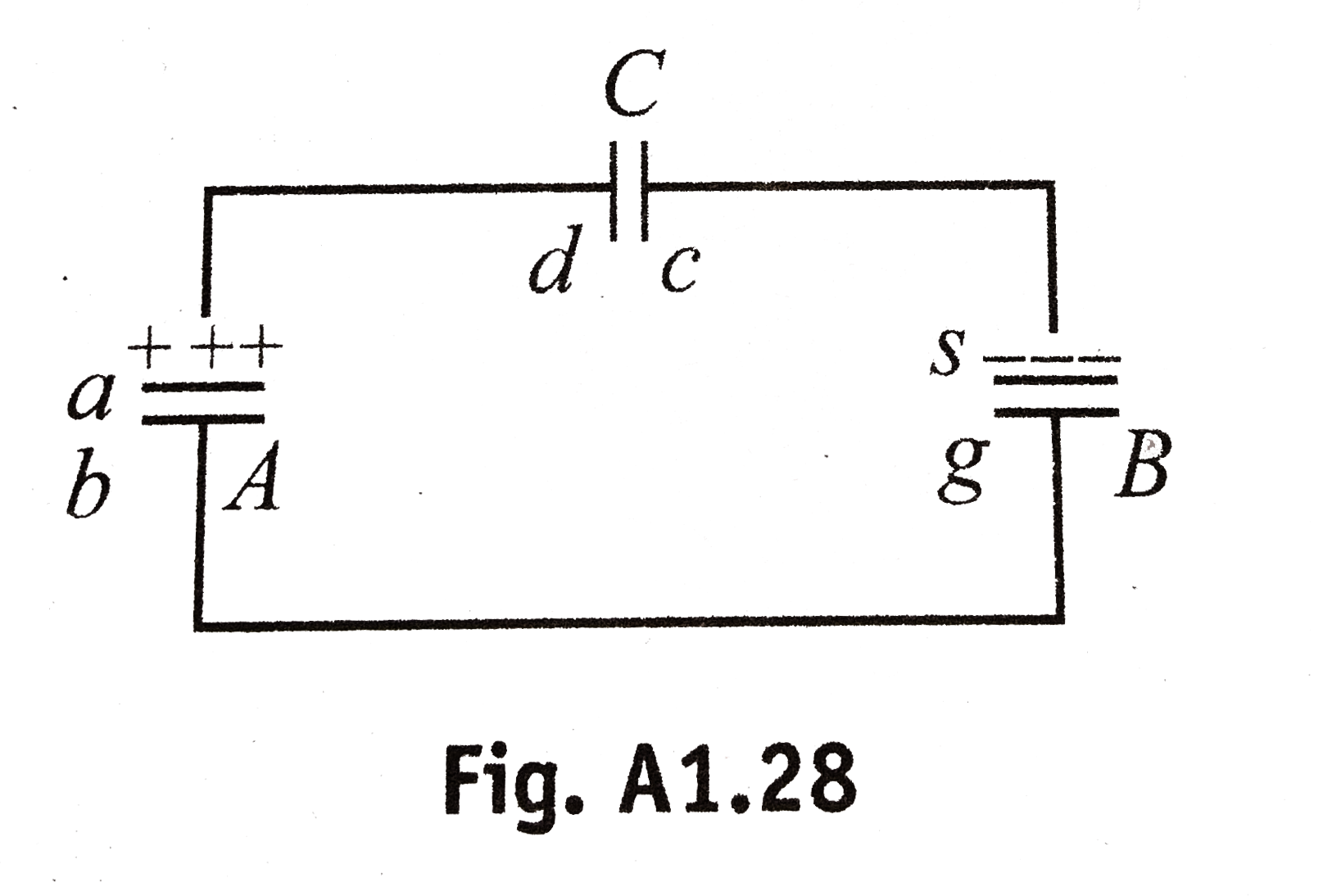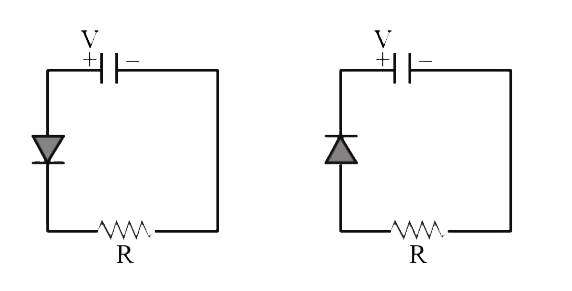Two identical capacitors, have the same capacitance C. One of them is charged to potential V1 and the other V2. The negative ends of the capacitors are connected together. When the poistive ends are also connected, the decrease in energy of the combined system is
14C(V21−V22)
14C(V21+V22)
14C(V1−V2)2
14C(V1+V2)2
The correct Answer is:C
To solve the problem of finding the decrease in energy when two identical capacitors are connected, we will follow these steps:
1. Identify Initial Energy (U1):
The initial energy stored in the two capacitors can be calculated using the formula for the energy stored in a capacitor:
U1=12CV21+12CV22
This can be simplified to:
U1=C2(V21+V22)
2. Determine Final Voltage (V):
When the positive ends of the capacitors are connected, the total charge is conserved. The common potential V across both capacitors can be calculated as:
V=CV1+CV2C+C=V1+V22
3. Calculate Final Energy (U2):
After connecting the capacitors in parallel, the final energy stored in the system can be calculated as:
U2=12(C+C)(V1+V22)2
Simplifying this gives:
U2=C(V1+V22)2=C4(V1+V2)2
4. Calculate the Decrease in Energy (ΔU):
The decrease in energy, denoted as ΔU, is given by the difference between the initial and final energies:
ΔU=U1−U2
Substituting the expressions for U1 and U2:
ΔU=C2(V21+V22)−C4(V1+V2)2
5. Simplify ΔU:
To simplify ΔU:
ΔU=C2(V21+V22)−C4(V21+2V1V2+V22)
This can be rewritten as:
ΔU=C4(2V21+2V22−V21−2V1V2−V22)
Simplifying further gives:
ΔU=C4(V21−2V1V2+V22)=C4(V1−V2)2
6. Final Result:
Thus, the decrease in energy of the combined system is:
ΔU=C4(V1−V2)2
The initial energy stored in the two capacitors can be calculated using the formula for the energy stored in a capacitor:
U1=12CV21+12CV22
This can be simplified to:
U1=C2(V21+V22)
When the positive ends of the capacitors are connected, the total charge is conserved. The common potential V across both capacitors can be calculated as:
V=CV1+CV2C+C=V1+V22
After connecting the capacitors in parallel, the final energy stored in the system can be calculated as:
U2=12(C+C)(V1+V22)2
Simplifying this gives:
U2=C(V1+V22)2=C4(V1+V2)2
The decrease in energy, denoted as ΔU, is given by the difference between the initial and final energies:
ΔU=U1−U2
Substituting the expressions for U1 and U2:
ΔU=C2(V21+V22)−C4(V1+V2)2
To simplify ΔU:
ΔU=C2(V21+V22)−C4(V21+2V1V2+V22)
This can be rewritten as:
ΔU=C4(2V21+2V22−V21−2V1V2−V22)
Simplifying further gives:
ΔU=C4(V21−2V1V2+V22)=C4(V1−V2)2
Thus, the decrease in energy of the combined system is:
ΔU=C4(V1−V2)2
Topper's Solved these Questions
- CAPACITORSBOOK - VMC MODULES ENGLISHCHAPTER - CAPACITORSEXERCISE - JEE Advance ( Archive ) LEVEL 13
1 Video
- CAPACITORSBOOK - VMC MODULES ENGLISHCHAPTER - CAPACITORSEXERCISE - JEE Advance ( Archive ) LEVEL 14
1 Video
- CAPACITORSBOOK - VMC MODULES ENGLISHCHAPTER - CAPACITORSEXERCISE - JEE Advance ( Archive ) LEVEL 11
1 Video
- BASIC MATHEMATICS & VECTORSBOOK - VMC MODULES ENGLISHCHAPTER - BASIC MATHEMATICS & VECTORSEXERCISE - Impeccable
50 Videos
- CURRENT ELECTRICITYBOOK - VMC MODULES ENGLISHCHAPTER - CURRENT ELECTRICITYEXERCISE - IN-CHAPTER EXERCISE-F
10 Videos
Similar Questions
A capacitor having capacity of 2μF is charged to 200V and then the plates of the capacitor are connected to a resistance wire. The heat produced in joule will be
View SolutionA parallel plate capacitor of capacitance C is connected to a battery and is charged to a potential difference V. Another capacitor of capacitance 2C is ismilarly charged to a potential difference 2V. The charging battery is now disconnected and the capacitors are connected in parallel to each other in such a way that the poistive terminal of one is connected to the negative terminal of the other. The final energy of the configuration is
View Solution
Knowledge Check
Two idential capacitors are joined in parallel, charged to a potential V and then separated and then connected in series i.e. the positive plate of one is connected to negative of the other
AThe charges on the free plated connected together are destoyed.BThe energy stored in the system increases.CThe potential difference between the free plates is 2V.DThe potential difference remains constant.
Two capacitor of capacitance 2μFand3μF respectively are charged to potential difference 20 V each. Now the capacitors are connected such that the positively chargd plate of one capacitory is connected to the negatively charged plate of the other. after the current in the circuit has become negligible, the potential difference across the 2μF capacitor is ____V.
View SolutionTwo capacitors with capacities C1 and C2 ,are charged to potentials V1 and V2 respectively.When they are connected in parallel,the ratio of their respective charges is ....?
View SolutionThree identical capacitors, each of capacitance C, are connected in series with a battery of emf V and get fully charged. Now the battery is removed and the capacitors are cannected in parallel with positive terminals at one point and negative terminals at other point. Then, The connon potintial will be.
View SolutionA capacitor of capacitance C1 is charged to a potential V1 while another capacitor of capacitance C2 is charged to a potential difference V2 . The capacitors are now disconnected from their respective charging batteries and connected in parallel to each other .
(a) Find the total energy stored in the two capacitors before they are connected.
(b) Find the total energy stored in the parallel combination of the two capacitors.
(c ) Explain the reason for the difference of energy in parallel combination in comparison to the total energy before they are connected.
View SolutionTwo capacitors A and B with capacities C1andC2 are charged to potential difference of V1andV2 respectively. The plates of the capacitors are connected as shown in the figure with one wire free from each capacitor. The upper plate of A is positive and that of B is negative. An uncharged capacitor of capacitance C3 and lead wires falls on the free ends to complete circuit, then

View SolutionA capacitor of capacitance 5μF is charged to potential 20V and isolated. Now, an uncharged capacitor is connected in parallel to it. If the charge distributes equally on these capacitors, find total energy stored in capacitors.
View SolutionTwo identical capacitors A and B are charged to the same potential V and are connected in two circuits at t = 0 as shown in figure. The charge of the capacitors at a time t = CR are respectively -

View Solution
